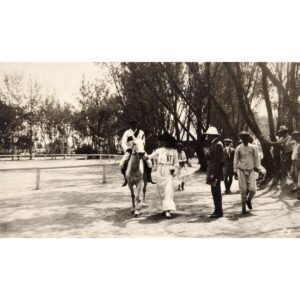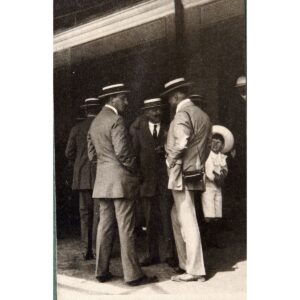Photography Officers’ Houses of the German Legation
A black-and-white photograph showing the officers’ houses of the German embassy or legation in the Legation Quarter in Beijing (Dongjiaominxiang 東交民巷). The latter was situated between 1861 and 1959 in the area of the Inner City (Neicheng 内城), east of present-day Tiananmen Square (Tiananmen Guangchang 天安門廣場), and south of the Forbidden City (Gugong 故宫 or Zijincheng 紫禁城). After the Second Opium War (1856–1860), several foreign delegations settled there and established legations of their countries. The city attracted many diplomats, soldiers, scholars, artists, tourists, and Sinophiles.
The German presence in China was important. It reached its symbolic peak in July 1901, shortly after the assassination of diplomat Clemens von Ketteler (1853–1900). At that time, the Chinese courtier Chun (Chun Qinwang Zaifeng 预親王載灃, reigned 1908–1911), the father of the last Chinese emperor Pu Yi (reigned 1908–1912, 1917), travelled to Germany ... more
A black-and-white photograph showing the officers’ houses of the German embassy or legation in the Legation Quarter in Beijing (Dongjiaominxiang 東交民巷). The latter was situated between 1861 and 1959 in the area of the Inner City (Neicheng 内城), east of present-day Tiananmen Square (Tiananmen Guangchang 天安門廣場), and south of the Forbidden City (Gugong 故宫 or Zijincheng 紫禁城). After the Second Opium War (1856–1860), several foreign delegations settled there and established legations of their countries. The city attracted many diplomats, soldiers, scholars, artists, tourists, and Sinophiles.
The German presence in China was important. It reached its symbolic peak in July 1901, shortly after the assassination of diplomat Clemens von Ketteler (1853–1900). At that time, the Chinese courtier Chun (Chun Qinwang Zaifeng 预親王載灃, reigned 1908–1911), the father of the last Chinese emperor Pu Yi (reigned 1908–1912, 1917), travelled to Germany to pay homage to the German emperor.
On August 14, 1917, China declared war on Germany and Austria-Hungary and ordered the seizure of the Austrian concession. The Austro-Hungarian crew temporarily joined the German crew. After the defeat by the British and Japanese forces, many soldiers and sailors fell into Russian and Japanese captivity. The officers, including Ivan Skušek Jr., served their captivity in Beijing.
The photograph is the 24th of 449 photographs of Beijing and its surroundings in the album of Ivan Skušek Jr., purchased during his stay in Beijing (1914–1920). In the handwritten inventory of the album, the photograph is referred to as Deutsche Gesandtschaft: Offizier-Häuser.





































Do you have a comment or additional information about the subject?